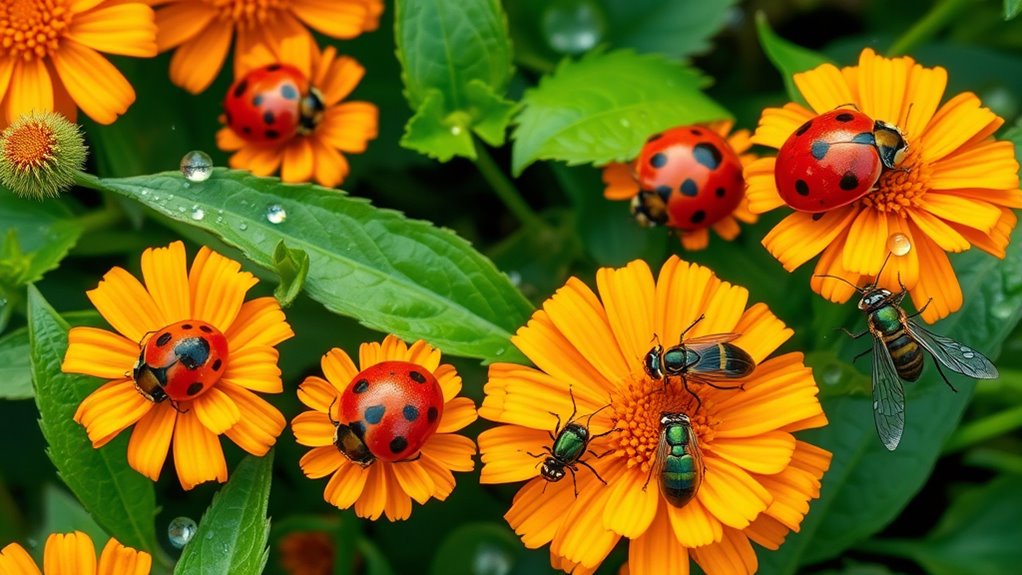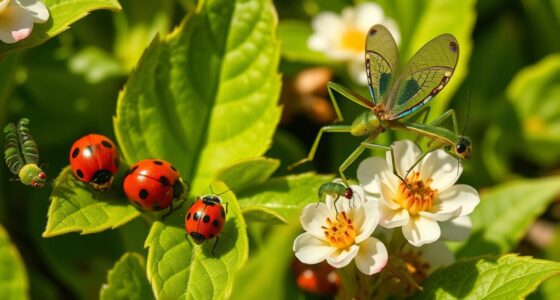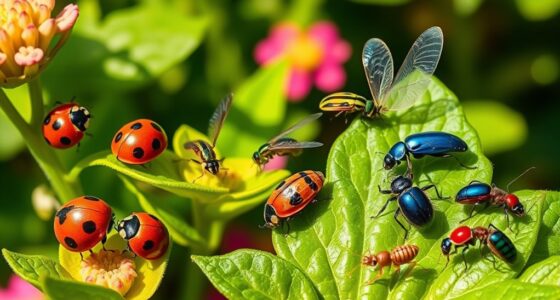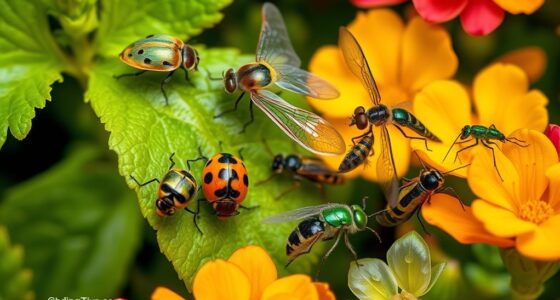To improve your garden naturally, focus on seven beneficial insects like lacewings, parasitoid wasps, bees, and hoverflies. Lacewings and hoverfly larvae help keep pests like aphids in check, while adult hoverflies and bees pollinate flowers and crops. Parasitoid wasps silently target pest insects from within, reducing the need for sprays. Creating a bee-friendly environment supports these helpful insects, ensuring a healthy, productive garden. Keep exploring to discover how each plays a crucial role in your garden’s success.
Key Takeaways
- Lacewings larvae naturally control pests like aphids, thrips, and whiteflies, reducing the need for chemical pesticides.
- Parasitoid wasps lay eggs inside pest insects, effectively killing them from within without harming plants.
- Bees enhance pollination, increasing flower and fruit production for healthier, more productive gardens.
- Hoverflies larvae feed on pests, while adults pollinate, providing dual pest control and pollination benefits.
- Creating a diverse, nectar-rich environment attracts beneficial insects, supporting sustainable pest management and crop health.

Similarly, lacewings are highly valued for their larvae, which feed on a variety of pest insects such as aphids, thrips, and whiteflies. You can attract lacewings by planting nectar-rich flowers like dill, fennel, or yarrow near your vegetable beds. Their presence not only helps control pest populations but also reduces the frequency and intensity of pesticide applications, allowing your plants to grow healthier and stronger. Additionally, supporting natural pest control methods like these reduces dependency on chemical pesticides, promoting a more sustainable garden ecosystem. Parasitoid wasps are another critical player in natural pest control. These tiny insects lay their eggs inside pest insects, such as caterpillars and aphids, effectively killing them from within. Introducing or encouraging these wasps can considerably reduce pest numbers without harming beneficial insects or your plants. They work silently in the background, supporting pest control strategies that rely on biological methods rather than chemicals. In addition to pest control, beneficial insects play a essential role in pollination techniques that boost flowering and fruiting. Bees, particularly native and honeybees, are crucial pollinators that transfer pollen from flower to flower, ensuring successful fertilization. By providing bee-friendly habitats—such as planting native flowering plants and avoiding pesticides—you enhance pollination efficiency, leading to more abundant harvests. Hoverflies are another example of beneficial insects that contribute to both pest control and pollination. Their larvae feed on aphids and other pests, while adults feed on nectar and pollen. Creating a diverse plant environment with a variety of flowering plants attracts hoverflies and other pollinators, helping your garden become more resilient and productive.
Frequently Asked Questions
How Can I Attract Beneficial Insects Naturally to My Garden?
To attract beneficial insects naturally, you should focus on plant companioning and organic gardening techniques. Plant a variety of nectar-rich flowers and herbs like dill, fennel, and daisies to provide food and habitat. Avoid chemical pesticides, as they harm beneficial insects. By creating a diverse, chemical-free environment, you encourage pollinators and predatory insects to thrive, helping you maintain a healthy, balanced garden ecosystem.
Are There Any Risks in Introducing Beneficial Insects to My Plants?
You might find it surprising, but introducing beneficial insects can sometimes pose risks. Pesticide interactions could harm these helpful bugs, reducing their effectiveness. Additionally, insect habitat modification might attract unintended pests or disrupt your garden’s balance. To minimize risks, avoid using broad-spectrum pesticides and create a suitable environment for beneficial insects. With careful planning, you can enhance your garden’s health without unintended consequences.
How Do I Identify Different Beneficial Insect Species?
To identify different beneficial insect species, you should focus on visual identification and species differentiation. Look closely at their size, color, shape, and wing structure, and note their behavior. Use field guides or online resources to compare what you see with documented images. Being observant helps you distinguish beneficial insects from pests, ensuring you support the right species in your garden and avoid accidental harm.
What Is the Lifespan of Common Beneficial Insects in Gardens?
Beneficial insect lifespan varies, but understanding their durations helps you appreciate their pest control power. Typically, beneficial insects like ladybugs live about a year, while hoverflies may only last a few weeks. This diversity demonstrates nature’s delicate dance, where different insects deliver dynamic pest control methods. By nurturing beneficial insect diversity, you support sustainable pest management, ensuring your garden remains healthy and harmonious over time.
Can Beneficial Insects Control All Types of Garden Pests Effectively?
Beneficial insects can’t control all garden pests effectively, especially if pests develop pest resistance or if you rely too much on chemicals. While they target many pests naturally, some pests might survive or adapt, making biological control less reliable. To succeed, you should integrate beneficial insects with other pest management strategies, reducing chemical reliance and helping prevent pest resistance, ensuring a healthier, more balanced garden ecosystem.
Conclusion
Incorporating beneficial insects into your garden really works—nature’s own pest control. Studies show that encouraging these helpful bugs can cut down on chemical use and boost plant health. So, next time you see a ladybug or a lacewing, remember they’re on your side. By trusting in nature’s balance, you create a thriving, eco-friendly garden. After all, sometimes the tiniest creatures make the biggest difference.









